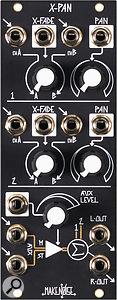Most small modular systems are monaural. In the past, creating a stereo modular has involved duplicating modules, which can be costly in both rack space and bank balance. The benefits of having single modules that can provide stereo processing are obvious then, and the X-PAN is here to help.
 Make Noise X-PAN.
Size: 10HP. Current: +12V 145mA, -12V 110mA.In essence, the X-PAN is a voltage-controlled mixer with crossfading and a stereo output. Housed in a 10HP module and adorned with Make Noise’s usual angular black graphics, the X-PAN is designed to be a high-quality mixer with VCAs that will respond quickly to CV control, allowing you to perform audio-rate modulations with crossfading and panning, which can result in some fascinating stereo effects.
Make Noise X-PAN.
Size: 10HP. Current: +12V 145mA, -12V 110mA.In essence, the X-PAN is a voltage-controlled mixer with crossfading and a stereo output. Housed in a 10HP module and adorned with Make Noise’s usual angular black graphics, the X-PAN is designed to be a high-quality mixer with VCAs that will respond quickly to CV control, allowing you to perform audio-rate modulations with crossfading and panning, which can result in some fascinating stereo effects.
This is not a full stereo mixer, however. Inputs are mostly monophonic, but the main output is stereo. The mixer is divided into three sections. The top two are identical and accept two mono inputs, which can take either audio or CV signals. These are fed first into a crossfader and then into a panning circuit. Both the crossfader and panner have their own dedicated knobs and CV inputs. The resulting stereo signal is then passed to the main stereo mix outputs.
The third section takes a stereo input and mixes it with the other two channels at the mix output. There’s a stereo VCA with a single CV input to control the level. Make Noise call this an Auxiliary input, but don’t confuse it with Aux send channels on a traditional mixing console. It’s more like a stereo Aux return channel.
Overall, this is a simple mixer, but a clever design. You get two crossfaders with panning, and a stereo input with level control. Make Noise market this as a stereo mixer, but I would contest that slightly because only the third channel will accept a stereo input. The lack of VCAs for level control on the first two channels can make balancing levels between all three channels tricky. You really need your signal levels correct before hitting the X-PAN. Given that the X-PAN already contains 10 VCAs (employed in the crossfading, panning and Aux channel), the lack of level controls for these two channels is an understandable design decision, but there were still times when I wished they were there. There is a workaround, however. If you are prepared to sacrifice one of the inputs on the first two sections, you can use the crossfader as a level VCA. Just don’t plug anything into the second input and your crossfader becomes a volume control. Using this method, the X-PAN becomes a three-channel mixer with two mono channels and one stereo channel, with volume controls for all.
Once again, Make Noise have developed a module that is flexible enough to end up in every patch, and just unusual enough to promote experimentation.
It took me a while to figure out exactly how and where the X-PAN would fit into a system. As I’ve come to expect from Make Noise, the ingenuity in the design takes a while to sink in. It is a flexible yet unusual design. I enjoyed feeding four different waveforms from an oscillator into the first two channels and using crossfading and panning to create a stereo synth voice. You can create some stunning binaural synth textures this way. Crossfading and panning at audio ranges creates some beautiful psychoacoustic effects too. Processing CV signals though the X-PAN is also possible thanks to DC-coupled inputs and outputs. Crossfading and mixing various sequencers and LFOs can produce highly complex CV signals, and in this scenario panning can be utilised for routing the CV signals to different destinations.
As a simple level mixer, the X-PAN may not be your first choice. You have to sacrifice an input to gain volume control over channels 1 and 2. If this is your primary need, you might want to consider alternatives which allow proper level control over every channel. If, though, your goal is crossfading and panning to a stereo output, the X-PAN could be the one. It is clearly designed as more than just a mixer. It encourages exploration of the stereo field and the audio quality is excellent with no discernible noise or distortion. I was reviewing the Make Noise QPAS stereo filter at the same time and the two play very nicely together and are worth considering as a pair. Once again, Make Noise have developed a module that is flexible enough to end up in every patch, and just unusual enough to promote experimentation.
